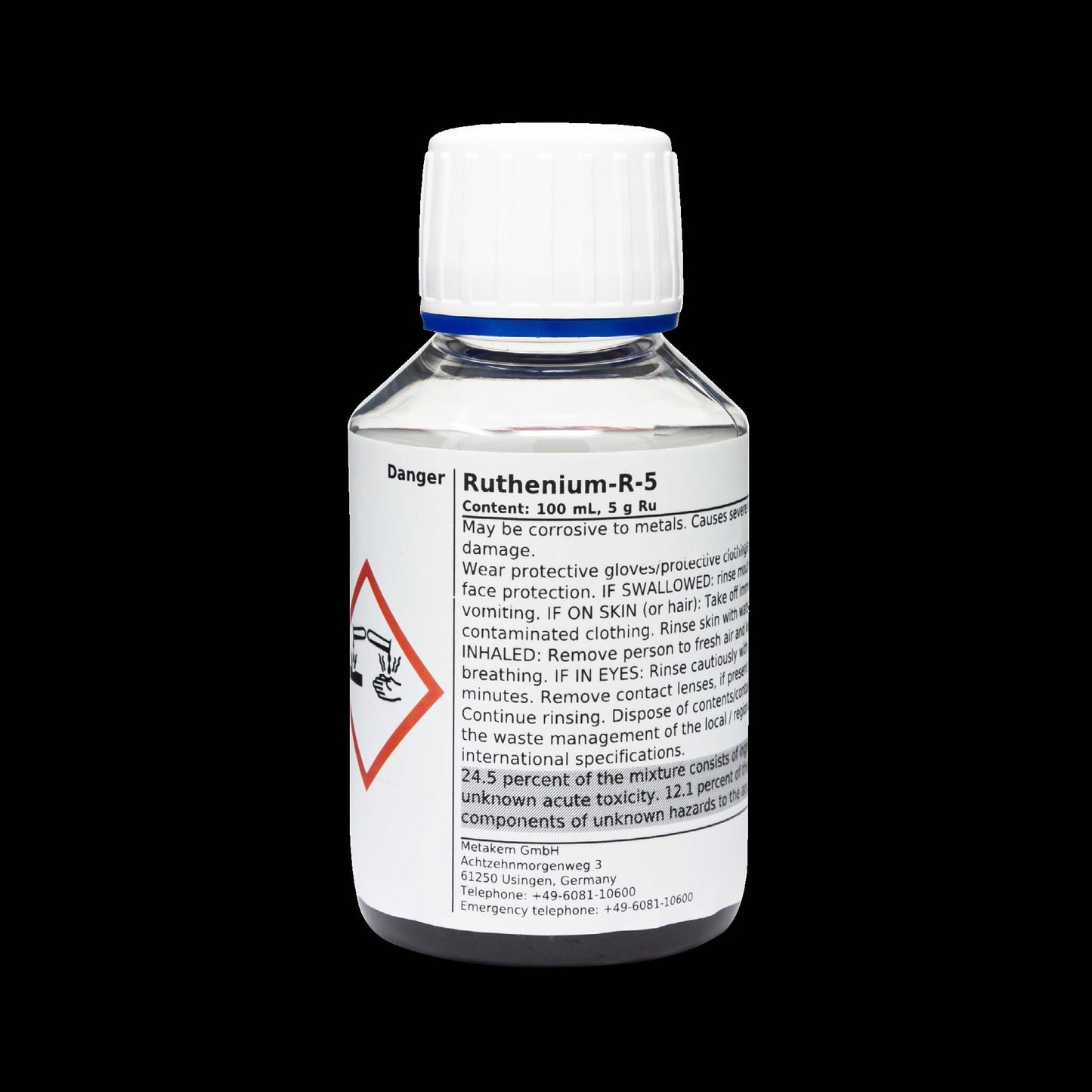Manufactured by Metakem, sold by Nano Cats GmbH
Ruthenium R 5
Ruthenium R 5
Couldn't load pickup availability
Ruthenium-R-5
A high-quality acidic ruthenium electrolyte designed for the deposition of ruthenium on electronic components, such as reed switches. The coatings are very hard (about 800 HV), maintain their gloss, and display high corrosion resistance. Although ruthenium layers have a grayish color, they possess similar functional properties to rhodium coatings and can be a cost-effective alternative. For decorative purposes, Ruthenium-R-5 is commonly used as BLACK Ruthenium-R-5, with blackening additive concentration controlling color intensity.
| Property / Parameter | Value / Description |
|---|---|
| Ruthenium Content | 5 (10) g / l (range: 4 – 8 g / l (8 – 12 g / l)) |
| pH Value | 1.5 (range: 1.0 – 1.8) |
| Operating Temperature | 70 °C (range: 60 – 75 °C) |
| Density | 1.02 g/cm³ (range: 1.02 – 1.04 g/cm³) |
| Voltage | 1.7 V at 1 A/dm² (range: 1.4 – 1.9 V) |
| Current Density | 1 A/dm² (range: 0.8 – 1.2 A/dm²) |
| Current Efficiency | 10 mg / Amin (range: 8 – 12 mg / Amin) |
| Exposure Time for 1 μm | 12 min at 1 A/dm² |
| Max Coating Thickness (without blackening additive) | Up to 1 μm |
| Max Coating Thickness (with blackening additive) | Up to 0.3 μm |
Bath Preparation:
For preparation of 100 liters: add 10 l of ruthenium concentrate (50 g/l) to 90 l deionized water to get 5 g/l Ru electrolyte.
Applications and Properties:
- Deposits hard, corrosion-resistant ruthenium coatings on electronics components
- Ruthenium layers are gray but functionally comparable to rhodium
- Blackening additives allow anthracite to black coloration, adjustable by additive concentration
- Recommended surface preparation includes degreasing, oxide removal, gold pre-coating and thorough rinsing
- Specific substrate materials (Zn, Sn, Pb, Fe, special bronze) require copper or nickel interlayers before ruthenium coating
- After plating, parts undergo rinsing and neutralization in warm diluted sodium hydroxide solution to remove electrolyte residues
Equipment and Process Conditions:
- Prefer polypropylene or polyethylene tanks with venting
- Use filtration pump with polypropylene cartridge filtration
- Ceramic or glass heaters with thermostat to control 60–75 °C
- Rectifier with continuous regulation
- Platinized titanium anodes (anode/cathode area ratio 2:1)
- Bath and cathode movement recommended
Maintenance:
- Maintain ruthenium concentration by adding ruthenium concentrate (50 g/l Ru plus other components)
- Control pH between 1.0 and 1.8 using ammonia or dilute sulfuric acid
- Typical deposition: about 50 g Ru per 5000 ampereseconds
Safety and Disposal:
- Contains free acid and is classified as irritant
- Avoid uncontrolled discharge into sewage or watercourses
- Spent electrolyte and rinse solutions should be processed by precious metal recovery facilities
- Ruthenium-free solutions must be detoxified according to local wastewater regulations
Blackening Additive (Ruthenium-R-5-B):
- Used for blackening ruthenium layers on base Ruthenium-R-5 baths
- Dosage: 2–6 ml per gram Ru depending on desired blackness level
- Continuous dosing (~4 ml/g Ru) recommended to maintain intensity during operation
- Blackening dye slowly decomposes at high working temperatures; adjust concentration after breaks
Share

